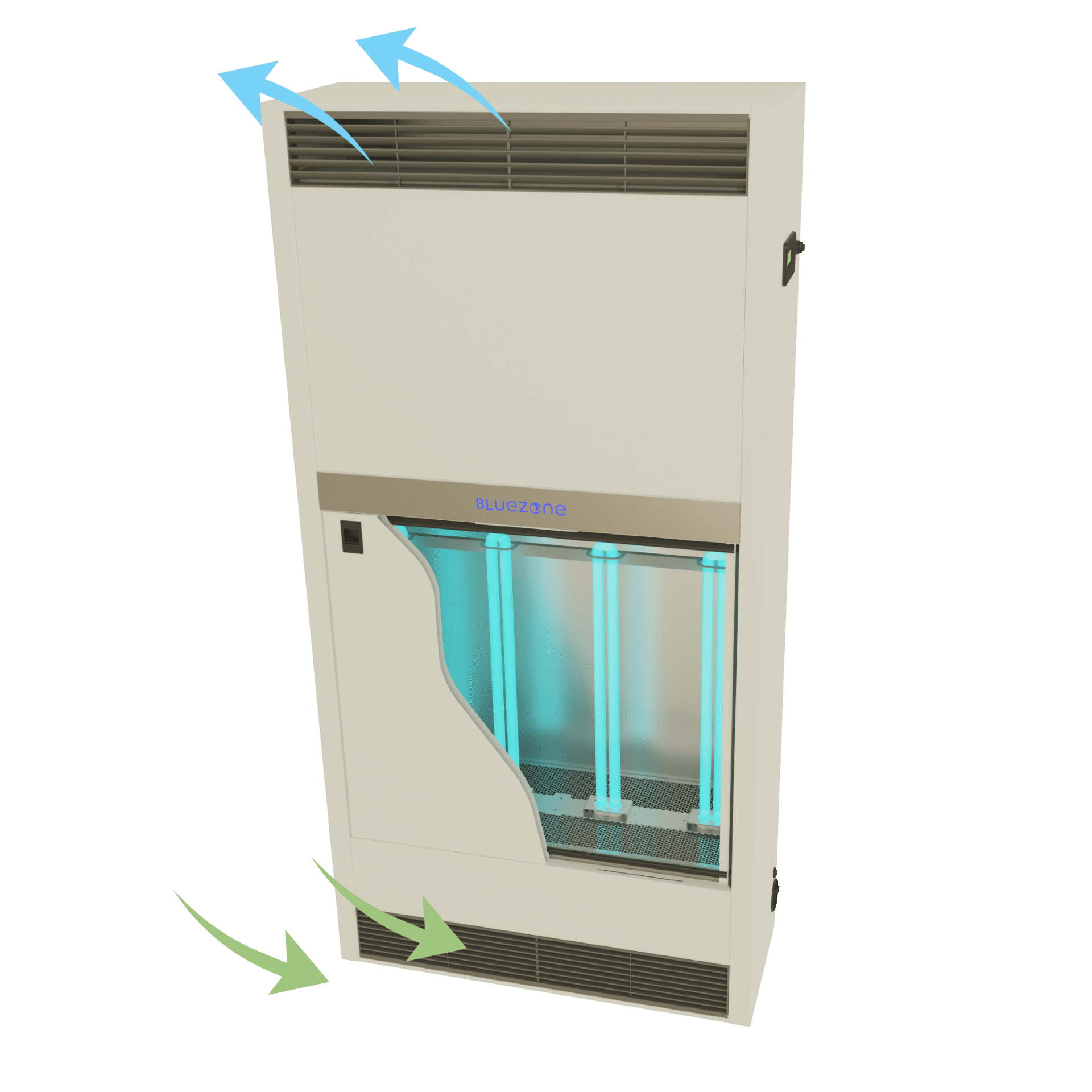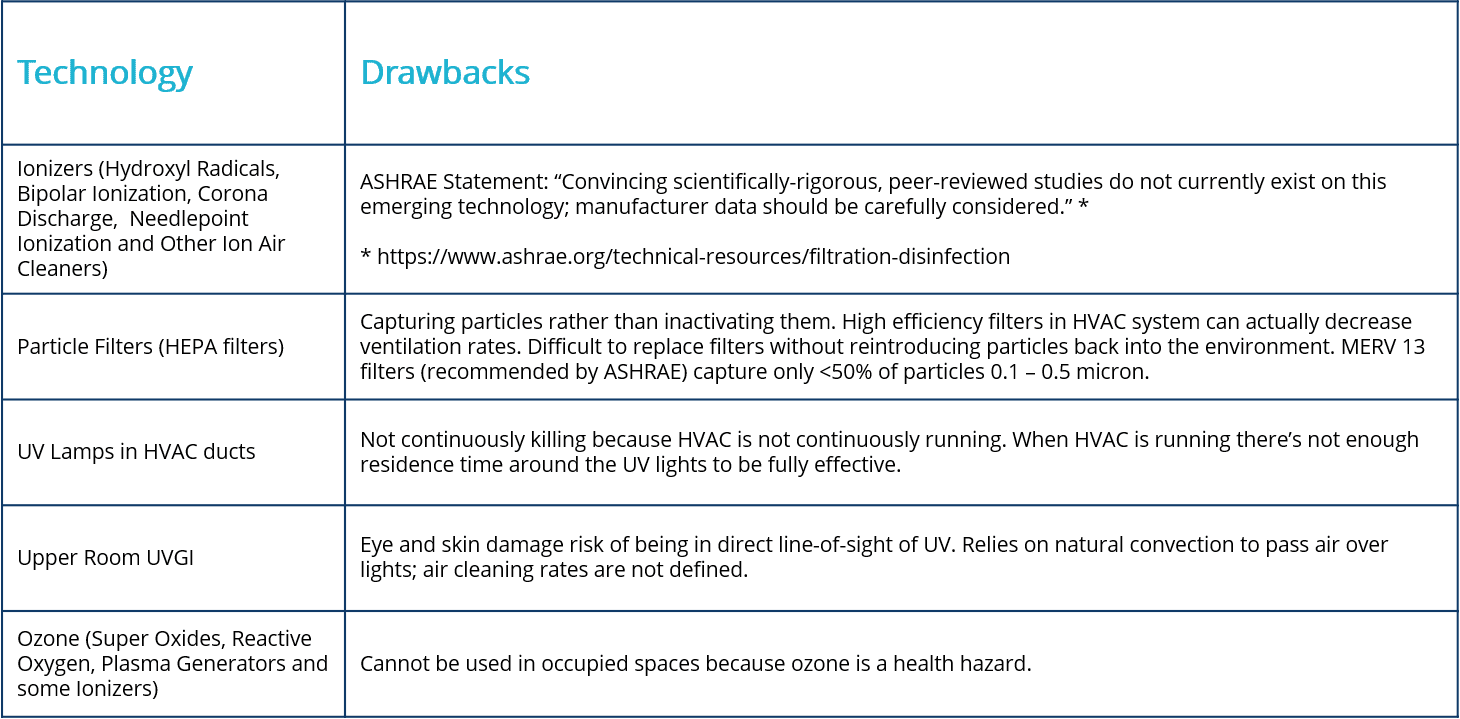The science of the spread, simply stated
Many studies have shown, and many public agencies have stated, that the SARS-CoV-2 virus is primarily transmitted through inhalation of airborne viral particles. Infectious particles are generated from individuals breathing, talking, sneezing, and eating and can remain in the air and infectious for hours.
As an infected individual continuously generates particles, the viral load in the room builds and the chances of transmission increases. To maintain clean and safe indoor air, continuous, highly effective and safe air cleaning must be implemented in high-risk spaces. Indoor spaces with high occupancy for extended periods of time pose a high-risk of virus transmission. If the spaces have limited ventilation the risk of transmission is greater. High-risk spaces include classrooms, conference rooms, auditoriums, gymnasiums, locker rooms, dining areas, common areas, and waiting rooms.
Stopping the spread
The three primary ways to mitigate virus transmission from person to person are air disinfection, air filtration, and dilution.
Air disinfection with ultraviolet germicidal irradiation (UVGI) continuously kills airborne viruses and mitigates transmission from person to person by maintaining a low airborne viral load. UV lamps emit high doses of UV light that kill airborne viruses by destroying their RNA. Not all UVGI is the same. Germicidal UV-C, 254nm wavelength, delivers the highest kill rate. UVGI must be contained because UV-C light is dangerous for the eyes and skin.
The CDC, FDA, EPA, ASHRAE, The White House, and a panel of 239 scientists recommend UVGI as an effective virus mitigation strategy. UVGI has been used for over a century to treat diseases. In 1903, The Nobel Prize in was awarded to Dr. Niels Ryberg Finsen for his use of UVGI to treat tuberculosis. This tried-and-true technology is considered the gold standard for virus and disease mitigation by many experts.
Air filtration uses particle or HEPA filters to contain and collect viruses in them. Filters are a common strategy and must be replaced regularly to maintain efficacy. Replacing filters contaminated with live viruses poses a safety hazard and must be done carefully. Not all filters are the same: they are rated for their efficiency in removal of small particles. Viral aerosols such as SARS-CoV-2 and influenza are very small particles. Typical filters capture less than 20% of particles 0.3 –1 micron in diameter. The coronavirus is smaller than 0.1 microns. The filters recommended for use to address the coronavirus, called MERV 13 filters, will allow 25% of particles 0.3 – 1 micron to pass through it.
Air dilution through increased ventilation is achieved by upgrading the HVAC system to provide adequate air exchanges. Indoor air is exchanged for outdoor air multiple times every hour. Not all HVAC systems can be updated to achieve adequate air exchanges; system overhauls may be required. Updated HVAC systems do incur excessive heating and cooling bills and may not be a sustainable long-term virus mitigation strategy.
The Bluezone PK-220 uses germicidal UV-C to deliver industry-leading virus protection at whisper quiet operation with limited maintenance

High efficacy
Demonstrated a 99.99993% kill of airborne viruses in an independent third-party lab test

Low maintenance
15 minute bulb change required every 8,800 hours of operation or every 1-3 years depending on operation schedule

Flexible install
Install on the floor, mount to the wall or install in a 2’x4’ drop-ceiling tile

Safe maintenance
No contaminated filters to replace
Military approved and implemented
Air cleaning developed and implemented for the US Army
Used by the US Navy: installed on all aircraft carriers
How Bluezone works

Competitive analysis
Bluezone products outperform all competing virus mitigation technologies in efficacy and safety.

Whitepaper
Download White Paper, Navigating Facility Safety in a Post-Mask World, by Karen Benedek, Bluezone CEO.
